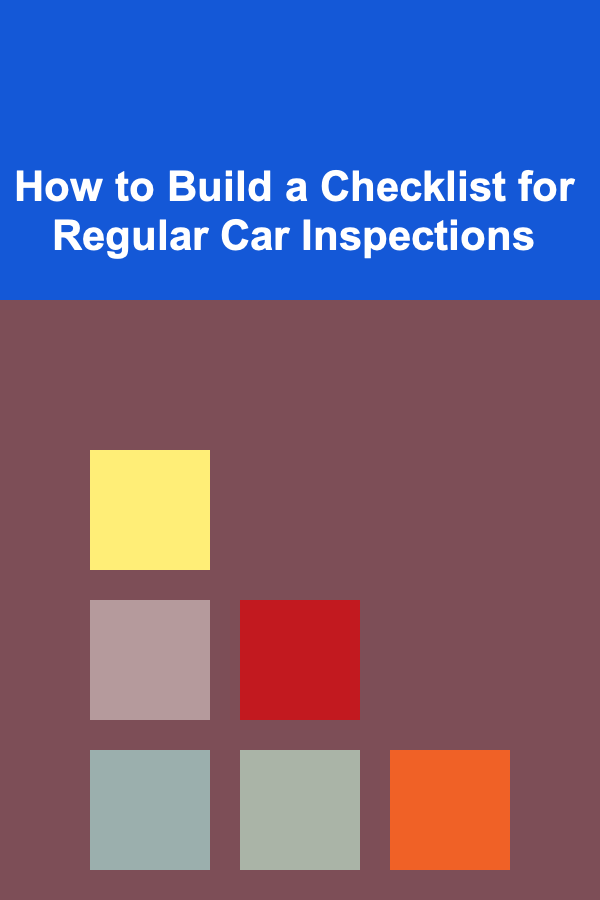
How to Build a Checklist for Regular Car Inspections
ebook include PDF & Audio bundle (Micro Guide)
$12.99$6.99
Limited Time Offer! Order within the next:

Regular car inspections are an essential part of vehicle maintenance. A well-maintained car is not only more reliable but also safer to drive, helping to avoid costly repairs and unforeseen breakdowns. Whether you're an experienced car owner or a first-time driver, building a checklist for regular car inspections ensures that you cover all the necessary bases, helping you maintain your vehicle in peak condition. This guide will walk you through the process of creating a comprehensive, actionable checklist for regular car inspections.
The Importance of Regular Car Inspections
Before diving into the specifics of the checklist, it's essential to understand why regular car inspections matter. Routine checks help you:
- Ensure Safety: A car that is regularly inspected is less likely to experience unexpected failures, reducing the risk of accidents.
- Save Money: Catching problems early can prevent minor issues from becoming costly repairs.
- Maintain Performance: Regular checks help keep your car running smoothly, ensuring optimal performance and fuel efficiency.
- Increase Longevity: Maintaining your car properly can extend its lifespan, giving you more value for your investment.
Regular car inspections typically involve checking key systems and components, ensuring that everything is in working order. These checks can be done at home or by a professional mechanic, depending on your expertise and the complexity of the tasks.
How to Build a Car Inspection Checklist
A comprehensive car inspection checklist includes a thorough review of both exterior and interior components, as well as systems that may require attention. Below, we break down each section of the inspection process, detailing the tasks you should perform and how often to conduct them.
1. Exterior Checks
The exterior of your car plays a critical role in its safety and appearance. Regular checks on the exterior components are crucial for identifying wear and tear, damage, or other issues that might affect the vehicle's performance.
Tires
- Check Tire Pressure: Low tire pressure can lead to reduced fuel efficiency and unsafe driving conditions. Use a tire pressure gauge to check that each tire meets the manufacturer's recommended pressure (found in the owner's manual or on the doorframe).
- Inspect Tire Tread: Inspect the tire tread depth. Worn-out tires can significantly reduce traction, especially in wet conditions. The minimum recommended tread depth is generally 2/32 inches.
- Look for Tire Damage: Examine tires for punctures, cuts, or bulges. Any visible damage requires immediate attention to prevent further issues.
Lights and Indicators
- Test All Lights: Ensure that your headlights, brake lights, turn signals, and hazard lights are functioning properly. Inspect both front and rear lights.
- Check for Lens Damage: Look for cracks or fogging in light lenses, which can reduce visibility. Clean any dirt or grime off the lenses to maintain proper lighting.
Windshield and Wipers
- Inspect Windshield for Cracks: Check the windshield for any cracks or chips. Even small cracks can worsen over time and impede visibility, requiring repairs or replacement.
- Examine Wiper Blades: Ensure that the wiper blades are free of damage and are effectively clearing the windshield. If they leave streaks or make noise, it's time to replace them.
- Check Windshield Washer Fluid: Keep the windshield washer fluid reservoir full to ensure that you have enough fluid to clean your windshield, especially during adverse weather conditions.
2. Under the Hood
Regular checks under the hood are crucial for the mechanical performance of your vehicle. Many of the car's core systems reside here, and overlooking them can lead to breakdowns or reduced efficiency.
Engine Oil
- Check Oil Level: Engine oil lubricates the engine, preventing overheating and wear. Use the dipstick to check the oil level, ensuring it's within the recommended range. If low, top up with the manufacturer-approved oil type.
- Inspect Oil Quality: Look at the oil's color and texture. Dark, thick, or gritty oil indicates that it needs changing. Regular oil changes are critical to engine health.
Coolant/Antifreeze
- Check Coolant Level: Low coolant levels can lead to engine overheating. Ensure that the coolant is at the proper level and top up if necessary. Check the color---bright green, orange, or pink typically indicates healthy coolant.
- Inspect for Leaks: Examine the coolant reservoir for any signs of leakage.
Belts and Hoses
- Inspect Belts for Wear: Check the engine belts for signs of cracking, fraying, or wear. Worn-out belts can affect the engine's performance and lead to breakdowns.
- Check Hoses for Leaks or Cracks: Look for any visible damage to the hoses, especially the radiator and power steering hoses. Cracked or leaking hoses can cause fluids to leak, leading to severe engine damage.
Battery
- Check Battery Condition: Inspect the battery for corrosion around the terminals. Clean off any corrosion using a baking soda and water solution.
- Test Battery Charge: Use a voltmeter to check the battery's charge level. If the battery is consistently low or has trouble starting the car, it may need replacing.
3. Interior Checks
The interior of your car is equally important for comfort, safety, and convenience. Regular checks can ensure that all features are working correctly and help prevent unnecessary repairs.
Brakes
- Check Brake Pads and Fluid: Inspect the brake pads for wear, and listen for any unusual sounds while driving (e.g., squeaking or grinding). Also, check the brake fluid level and top it up if necessary.
- Test Brake Performance: During a test drive, check the responsiveness of the brakes. If they feel spongy or take longer to stop, there may be an issue with the brake system.
Air Conditioning and Heating
- Test the A/C: Ensure that the air conditioning is cooling properly. If the airflow is weak or the temperature isn't adjusting, it could indicate an issue with the compressor or refrigerant levels.
- Check the Heater: Ensure the car heater is working efficiently. A malfunctioning heater can make winter driving uncomfortable and unsafe.
Dashboard Indicators
- Monitor Warning Lights: Pay attention to the warning lights on your dashboard, such as check engine, tire pressure, or oil lights. These signals indicate potential issues that need immediate attention.
- Check for Fluid Leaks: Keep an eye on your dashboard's fluid level warnings, such as coolant, oil, and brake fluid. If any of these indicators light up, investigate and resolve the issue as soon as possible.
4. Additional Routine Checks
There are a few other areas that may not always be top of mind but are important to check periodically to maintain your car's optimal condition.
Alignment and Suspension
- Check for Uneven Tire Wear: Uneven wear on tires can indicate misalignment, which affects the handling of your vehicle. Have the alignment checked regularly.
- Test Suspension by Driving: During a test drive, listen for any unusual noises (e.g., clunking or squeaking) and check for an uneven ride.
Fuel System
- Inspect the Fuel Tank Cap: Ensure the fuel tank cap is properly sealed to avoid fuel vapor leakage, which can lead to poor fuel efficiency and emissions problems.
Exhaust System
- Check for Leaks: Inspect the exhaust system for any rust or leaks that might cause harmful emissions to escape into the cabin. A damaged exhaust system should be repaired immediately.
How Often Should You Perform Inspections?
- Monthly: Perform a quick visual inspection of tires, lights, and windshield wipers. Check fluid levels (engine oil, coolant, brake fluid).
- Every 3-6 Months: Conduct a more in-depth check of belts, hoses, brakes, and the battery. Consider taking your car to a professional mechanic for a comprehensive inspection.
- Annually: Perform a thorough inspection of all car systems, including the exhaust, suspension, and alignment. This is also a good time to schedule an oil change and tune-up.
Conclusion
A regular car inspection checklist is essential for ensuring the safety, performance, and longevity of your vehicle. By adhering to a routine inspection schedule, you can catch minor issues before they become major problems, ultimately saving money on repairs and improving your driving experience. Always stay proactive, maintain a solid inspection routine, and consult a professional mechanic when necessary. Your car---and your wallet---will thank you!
Reading More From Our Other Websites
- [Gardening 101] How to Choose the Perfect Fence Style for Different Garden Themes
- [Home Cleaning 101] How to Remove Odors from Your Home Without Chemicals
- [Ziplining Tip 101] Soaring Above the Fear: How Ziplining Can Conquer Your Height Anxiety
- [Home Budget 101] How to Evaluate Your Spending Habits for Better Budgeting
- [Home Staging 101] How to Stage a Home for a Quick Sale: Fast and Effective Strategies
- [Gardening 101] How to Choose the Perfect Garden Shed for Your Storage Needs
- [Home Family Activity 101] How to Share Responsibilities in Family Activities
- [Personal Care Tips 101] How to Use Body Butter to Soothe and Revitalize Tired Skin
- [Organization Tip 101] How to Create a Functional and Stylish Outdoor Kitchen
- [Personal Care Tips 101] How to Create a Lip Balm Routine for Soft Lips

How to Create a Rental Property Marketing Strategy
Read More
How to Make the Most of a Narrow Entryway
Read More
How to Use Under-Bed Storage for a Clutter-Free Bedroom
Read More
The Ultimate Guide to DIY Arts and Crafts Supplies for Beginners
Read More
How to Plan Social Media Around Industry Events & Conferences
Read More10 Tips to Automate Your Cash Flow Projection Tracker
Read MoreOther Products

How to Create a Rental Property Marketing Strategy
Read More
How to Make the Most of a Narrow Entryway
Read More
How to Use Under-Bed Storage for a Clutter-Free Bedroom
Read More
The Ultimate Guide to DIY Arts and Crafts Supplies for Beginners
Read More